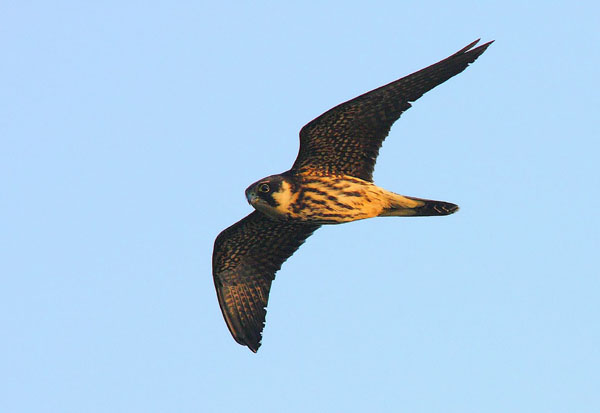Falco subbuteo
IUCN
LCBasic Information
Scientific classification
- name:Falco subbuteo
- Scientific Name:Green stripe, earth falcon, falcon, grasshopper hawk, insect kite
- Outline:Raptor
- Family:Falconiformes Falconidae Falco
Vital signs
- length:28-35cm
- Weight:120-294g
- lifetime:15~25year
Feature
When the wings are folded, the wing tips almost reach the end of the tail feathers, which looks very much like a swallow, hence the name.
Distribution and Habitat
The Eurasian Hobby is found in almost all areas of China except the desert hinterland and the Qinghai-Tibet Plateau. It is mostly a summer migratory bird and a traveling bird. It winters in southern Tibet and southern China, but it has not been recorded in Hainan Island. It is widely distributed in the Palearctic abroad. It winters in southern China, Indochina, South Asia and southern Africa during the non-breeding season.
The Eurasian Hobby lives in open habitats, fields, coasts, sparse forests and forest edges below 3,000 meters above sea level with sparse trees and shrubs, and sometimes near villages. In the Himalayas, it has been recorded that it is active at an altitude of 4,000 meters. It nests in tall trees in sparse forests or forest edges and fields, often occupying ready-made bird nests such as crows and magpies.
Appearance
The Eurasian Hobby is a small bird of prey, a relatively small falcon. It has no obvious wing fingers. The male and female are the same type. It has a slender body similar to that of a large swift, and the wing tips slightly exceed the tail end when it is perched. The adult bird is white with thick black vertical stripes, and the tail is very long. The head is black, with two thick sideburns extending under the eyes and ears, like a "helmet". The feathers from the lower abdomen to the underside of the tail are red, the eye circles, beak, and legs are yellow, and the claws (nails) are black. The immature bird is also similar to the adult bird, but the body color is slightly dark yellow, and the buttocks are not red.
Details
The falcon is commonly known as the green-striped hawk, grasshopper hawk, and green-tip hawk. It is smaller than the peregrine falcon and the peregrine falcon. It moves alone or in pairs and mainly hunts in the air. It flies at high speed, is agile, and flexible, like a fighter jet. It can even catch fast-flying swallows and swifts. It also often preys on other passerine birds, bats, dragonflies, crickets, locusts, longhorn beetles, beetles, and other large insects. Most of them are pests.

It mainly hunts in the air and can even catch fast-flying swallows and swifts. Although it is active during the day like other falcons, it hunts most frequently at dusk. It often flies over fields, forest edges and swamps to hunt, and sometimes hunts on the ground.
The breeding season is from May to July. After mating, the male bird often holds food in its mouth and approaches the female bird in a stilt-walking posture, nodding its head continuously while spreading its legs to reveal its inner feathers, and then hands the food to the female bird, completing the bowing ceremony between them. Then the male and female birds fly together in the air, accompanied by their unique monotonous and soft calls.
Call: Repeated sharp call kick.








